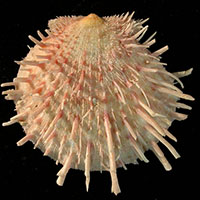|
< Previous family introduction |
|
|||||
 |
Family Spondylidae Spiney Oysters
|
|||||
|
The Spondylidae is a family of small to large, solid, heavy, spikey shells. There are about 65 species in the family (Huber, 2010). The family is predominately tropical, with over 80% of the species being found in the Indo-West Pacific. Most species are sublittoral, living at 10-100 m but a few live below that range and down to 1000 m. Shells are usually cemented to the substrate – rocks, corals, man-made structures – but a few, including the single southern Australian species S. tenellus, are free living. Family Reference Lamprell, K. 2006. Spiny Oysters: a revision of the living Spondylus species of the world. Jean Lamprell: Brisbane, Australia. Coverage The single species from NSW is detailed here. Identification Notes Spondylus shells are decorated with spines of arrangement, size and shape peculiar to each species, but these spines are worn or broken in normal circumstances. For accurate identification a range of good specimens is needed, as there is variation within a species. It is usually difficult to identify worn, beach collected shells unless there is some supporting information, such as habitat or locality data. Additional Species Spondylus nicobaricus Schreibers, 1793 Occurs in the Mediterranean Sea and widely distributed in the Indo-West Pacific, including northern Australia. Reported from Hastings Point and Brunswick River, northern NSW (Riek, 2024). Potentially, two additional species could also occur in northern New South Wales – Spondylus tenuitas Garrard, 1966 and S. victoriae G.B. Sowerby II, 1860 – since both are recorded subtidally from Moreton Bay, southern Queensland.
|